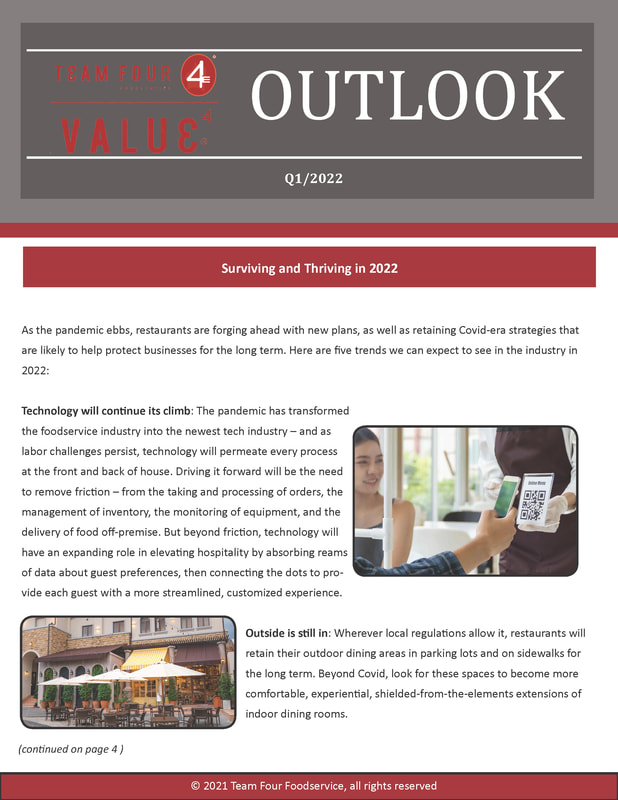 The pandemic ushered in significant (and seemingly permanent) changes to people’s working environments. According to Gallup research, 52 percent of employees in the U.S. work in hybrid offices or at home. This has caused a shift in not only where consumers are eating their meals, but to their eating habits themselves. The U.S. Chamber of Commerce reports that as consumers continue to spend more of their time in their suburban and rural neighborhoods, some restaurants have adjusted their growth plans and followed their guests there. At the same time, this shift to the suburbs has resulted in a broader spread of business throughout the day as opposed to rushes during mealtimes. It can be a disruptive transition. Less people are having take-away lunch at their desks and operators are having to think about keeping dining room space available to people eating at odd hours, as well as to guests coming in with baby strollers. For some, the imbalance of traffic across the day means having to have a mixed-use plan for their real estate that allows them to continue to make sales regardless of the ebb and flow of traffic in a suburban location. Staffing can present another challenge if restaurants are used to sharing workers across multiple urban locations and now have spread-out suburban stores to staff. That said, these locations are experiencing appealing growth – and by becoming a fixture in people’s neighborhoods, a business may be more able to become a valuable part of their family and social experiences. There is opportunity to build loyalty and benefit from partnerships with other local businesses that enrich the fabric of the community. If you’re investing more in suburban guests right now, what opportunities do you see to boost their experience with you, as well as build their loyalty?  Nearly three-quarters of the U.S. food supply is ultra-processed, according to new research published by Northeastern University’s Network Science Institute, and these foods generate a higher risk of developing a variety of health problems. Consumer awareness is growing around the connection between ultra-processed foods and poor health. This could well have an impact on the dining choices of those who have grown more health-conscious in recent years, since conventional wisdom says the best way to ensure you’re consuming a healthy diet is to prepare your meals yourself. But that doesn’t have to be the case. More foodservice suppliers are looking to support consumer interest in healthy lifestyles while providing the taste and variety that can make nutritious eating easier to maintain – so there is significant opportunity for foodservice operators here. U.S. Foods, for one, has an “unpronounceables list” of 80 ingredients they avoid or replace in the foods they develop for select foodservice clients. The list contains items such as artificial colors or flavors, nitrites and nitrates, and high-fructose corn syrup. “This appeals to many of our customers looking for products that are produced with clean-label profiles similar to what they might make themselves back of house,” said Stacey Kinkaid, U.S. Foods vice president of product development, in an interview with Food Business News. The company uses the AI-supported e-commerce portal MOXe to suggest ingredients that suit the evolving preferences of their clients’ guests, so it is likely to become easier for foodservice operators to find ingredients and substitutes that meet their need for minimally processed menus.  Limited-time offers can revive guest excitement about your restaurant: According to the director of menu research and insights at Technomic, 52 percent of consumers say the availability of an appealing LTO is important to them when they are deciding which restaurant to visit. Restaurants have responded, with LTOs spiking 46 percent at both quick-service and full-service restaurants. But LTOs aren’t necessarily easy to execute. The quality of the planning behind them can help ensure you’re offering not only the kinds of options that your guests will crave, but also ones that help you minimize pain points and maximize opportunities in your business. Here are some questions to ask as you develop new potential concepts: How can you connect this offer to the time of year, or to what’s happening in the world? How can you make it feel exclusive, so guests know they won’t find this offer elsewhere? What about this LTO will pique someone’s interest when they see it on a social media post? What time frame and marketing approach will best motivate people to buy from you right now? How can you use more of the ingredients you would most like to include – and avoid those you don’t? What pain points – e.g., complicated prep – do you want to avoid? How can you use your guest data to craft offers that speak to them? (Technomic found that younger consumers tend to be more willing to try new LTOs, for example, while older consumers tend to lean toward nostalgic tastes.) Finally, how can you mine your guest data to make sure your offer is getting traction – and apply those lessons when developing future offers?  No doubt, the past several years have pushed restaurants to think outside of the box. Since the pandemic, restaurants have invented new income streams as a means of stabilizing income in challenging times. Challenges persist for many restaurants right now, albeit in different forms than they did in 2020, and creative solutions continue to emerge to help operators respond to consumer cravings in ways that help them compete. One case in point: More restaurants are now cross-selling each other’s menu items. As Restaurant Business reported recently in their Restaurant Rewind podcast, restaurant licensing deals are expanding beyond their usual boundaries. In addition to visiting a grocery store and being able to pick up a packaged pizza from a national chain, consumers are seeing more of their favorite ready-to-eat restaurant foods at unexpected restaurants. For example, Cinnabon-branded products are popping up at restaurant brands including The Cheesecake Factory, Wendy’s and Subway. Menu items from Pret A Manger will soon be available at A&W restaurants in Canada. At a time when boundaries have been blurring around where consumers can access the foods they crave – and the rise of “grocerants” continues to make grocery stores into destinations for ready-to-eat foods – this latest development may help restaurant brands extend their reach. What’s more, it might help them strengthen new income streams to support profitability. Looking at your restaurant, are there opportunities for you to place your most in-demand products in complementary restaurants?  It’s that time of year when a cool drink can be even more appealing than a meal or snack. What’s more, a new survey by Revenue Management Solutions found that specialty drinks can be revenue powerhouses for foodservice operators – largely because they break many of the rules consumers tend to follow when it comes to their spending. Specifically, when the 600-plus people participating in the survey were asked about their purchasing habits, 80 percent of respondents said they order specialty drinks multiple times a week, even though they reported a drop in their overall restaurant visits. One in four respondents said they order specialty beverages more than once a week – even though almost half of respondents said they are ordering less in order to save money right now. Specialty drinks are also ideal items for people to enjoy on the go or at home – and according to the survey, people who use delivery are less sensitive to price than guests using other sales channels. There might be an opportunity for you to include specialty drinks as an upsell suggestion on your app, where people might be more open to paying a bit more, or for you to promote them as a special limited-time offer. If you’re looking into expanding your menu offering in this area, consider a diverse mix of options: The survey found that tastes differ across generations, with younger consumers preferring sodas and soft drinks, and older consumers opting for house-made drinks. Flavor and price were the top factors affecting a person’s purchasing decision. Other key themes stood out: The top beverage choice was hot or iced coffee, earning 82 percent of the vote, followed by soft drinks. While 80 percent of respondents ordered their beverages from coffee shops, 76 percent ordered them from restaurants, so respondents perceive restaurants as places to go for an appealing drink, whether it’s coffee or not. Recommendations from friends and family played an important role in respondents’ decision to buy too, so giving people an incentive to spread the word with others if they enjoy their drink can help boost traffic and sales.  When Mintel released its 2024 Global Food and Drink Trends report, they predicted that this year, we should “expect brands to help consumers live longer, healthier lives.” To be sure, consumer consciousness about health and nutrition has been on an upward trend in recent years, with growing awareness about functional food and drink, the degree of processing involved in what we consume, and the ability of food to help extend the healthy years of a person’s life. To that end, restaurant brands are responding to this environment in new ways. For one, Nation’s Restaurant News reports that the quick-service salad brand Salad and Go recently named its first-ever salad nutrition officer, registered dietician Maya Feller. On the Salad and Go website, Feller is providing tips to help guests incorporate more healthy food into their diets, as well as collaborating with the restaurant’s chef on a video series aimed at dispelling food myths and misconceptions, the report says. If making healthier choices is important to your guests and a key component of your restaurant’s brand, there are steps you can take – both direct and subtle – to nudge people in a healthier direction when it comes to their food and drink. You can promote the pleasure of healthier items with descriptions that focus on taste as opposed to health benefits – “citrus-glazed carrots” as opposed to “fiber-rich carrots,” for example. You can also place healthier options front and center when guests are reviewing the menu, flag them with special logos on your menu, or suggest them as side dish options when upselling an order.  In the past, takeout business was often a nice-to-have option for restaurants – not necessarily the centerpiece of service. But that is changing – and restaurants are finding ways to translate the success of a brand with a solid on-premise history into one that doesn’t offer much of an on-premise experience. One example: Inspire Brands’s Buffalo Wild Wings restaurant. As CNBC reported recently, the sports-bar chicken wing brand launched a quick-service, delivery-and-takeout-only offshoot called BWW Go four years ago – and they have opened 100 locations since then, with another 50 planned for the remainder of the year. Takeout and delivery sales for Buffalo Wild Wings are now around 33 percent of all sales, up from 15 percent pre-pandemic, according to the business. The restaurant’s off-premise play seems to have worked because their customer base enjoys staying home to watch the big game, their product is not only popular and easy to customize but also travels well, and many customers know and trust the brand from their on-premise experience there. If, like many restaurants, you’re experiencing a surge in off-premise sales in recent years, how comfortable are you with how your brand translates outside of your dining room? Could you offer menu items that travel better? Are you finding ways to bring the personality of your brand into people’s homes with every takeout order? Are your delivery partners preserving your commitment to service – or could you incentivize customers to collect their food from you so you can strengthen face-to-face engagement? Or is your brand ripe for a Buffalo Wild Wings-style reinvention, with an off-premise offshoot that reliably provides the experience customers expect from the parent brand?  Perhaps it has to do with the flexibility of post-pandemic schedules, the rise in hard-to-acquire dinner reservations in various places around the country, the need for restaurants to maximize sales opportunities, or all of the above, but the demand for quality lunch options appears to be on the rise. According to one restaurateur in a recent report from Eater New York, lunch has become the “new post-pandemic 5 p.m. reservation,” with multi-course, prix-fixe lunch menus popping up around the city. Offering enhanced lunch options could work well beyond major metropolitan areas like New York: Dinner reservations are becoming more difficult to secure at restaurants in many cities and towns around the country, and recent reports have indicated that restaurants are seeing more opportunity in catering (which has a lot of sales potential at lunchtime). Lunch could be an opportunity to give guests access to an elevated experience for what feels like a better value, provide your staff greater flexibility with scheduling, and make more efficient use of your space and inventory. Could innovating at lunchtime work for your business?  Devoting more of the menu to vegetables isn’t simply on-trend right now – it’s also an ongoing strategy for managing supply chain snags and inflation concerns, particularly as restaurant pricing continues to outpace grocery store pricing. According to recent research from Nation’s Restaurant News, 58 percent of restaurant operators of all sizes and service styles name supply chain problems and inflation as their biggest pain points right now. But at a time when consumers are looking for their restaurant experience to feel like a good value, operators aren’t able to sacrifice service or menu development in an effort to cut costs. Could reimagining your menu help? A recent Restaurant Hospitality report says more chefs are looking to further reduce large-format animal proteins and incorporate vegetables in creative ways in order to counteract the high costs of ingredients, labor and transportation, as well as to better manage the availability of ingredients. That could mean pushing the vegetarian content on menus toward the 30 percent mark for restaurants that have traditionally served more meat. This summer could be a good time to integrate more local produce on the menu and preserve it in a range of ways for the cooler months – not in an aim to mimic meat but to offer an unexpected experience with plants. Combine these foods in vegetable-forward dishes with beans, legumes, hearty whole grains and other satisfying plant proteins to test potential applications in the center of the plate – and to gather guest input too.  Despite all that has been done to simplify restaurant menus in the past few years, it appears there may be room to go further. Restaurant Business says that according to a newly published survey of 1000 consumers by U.S. Foods, the average restaurant guest spends nine minutes perusing the menu before ordering — and for the vast majority of guests, that is on top of the time they spend skimming the menu before arriving at the restaurant. Further, even though 82 percent of guests said they prioritize convenience when they choose where to eat, the average guest spends 23 minutes contemplating what to eat — not the most convenient way for guests to access restaurant food (or the most efficient way for restaurants to turn tables, either). So where is there room for change? Most consumers surveyed said they dislike QR codes and even more said that physical menus should be available at restaurants, so it sounds like the physical menus themselves still need greater simplification and clarity. The survey found that more than half of consumers said they still felt they had too many options to consider on restaurant menus, while 79 percent said they struggle to decide what to order. They key elements that consumers said they preferred on menus included clear descriptions that listed all ingredients, images of menu items, and prices, so you might consider these factors as a guide. In your on-site interactions with guests and in guest reviews, do you detect signs that your menu needs further simplification? Are guests confused by the variety of options, looking for ways to modify existing menu items, or struggling to find items in their price range? As you optimize your menu in the coming months, there may be opportunities to refine your options and make the process of ordering from you faster and more convenient. |
Subscribe to our newsletterArchives
July 2024
Categories
All
|




 RSS Feed
RSS Feed